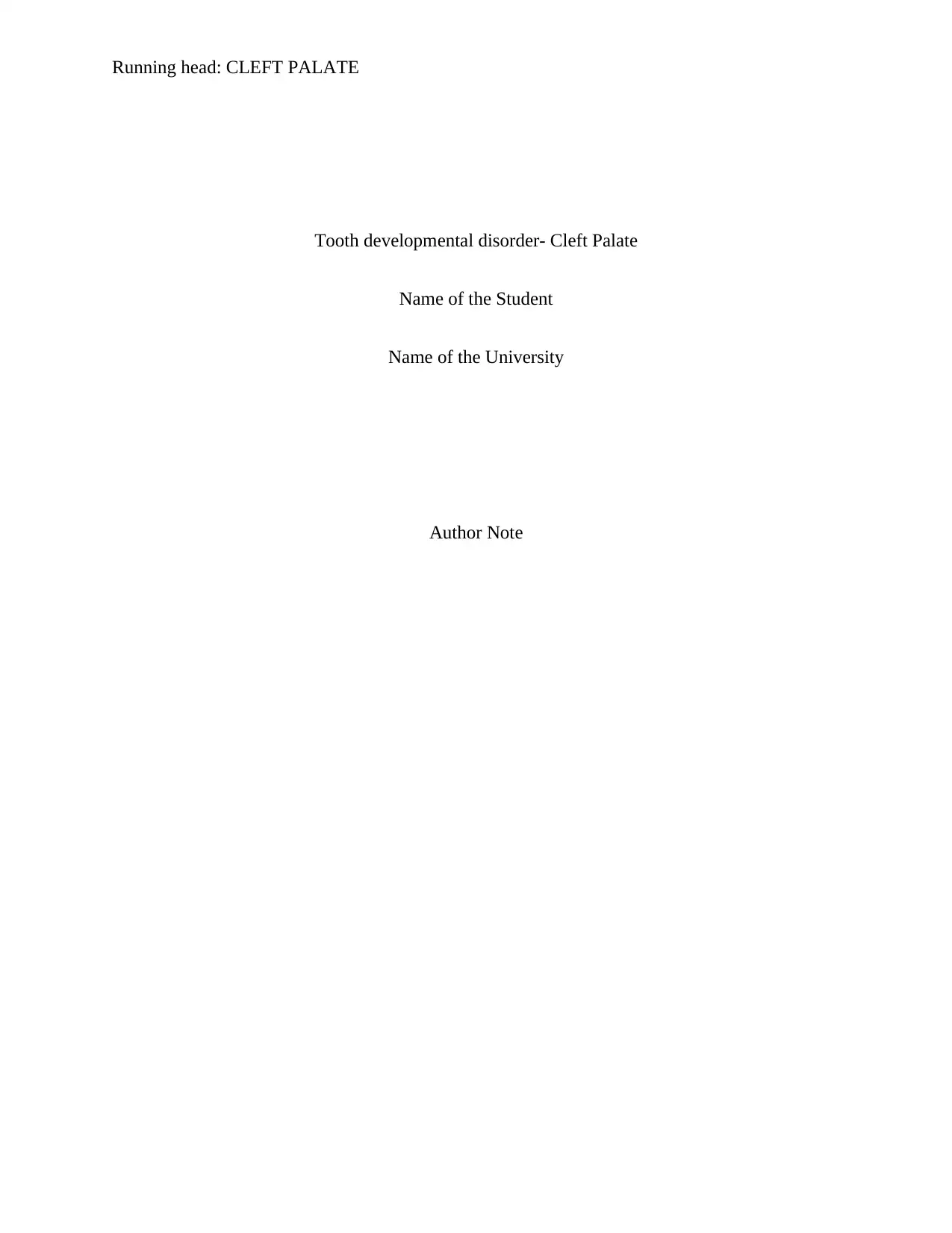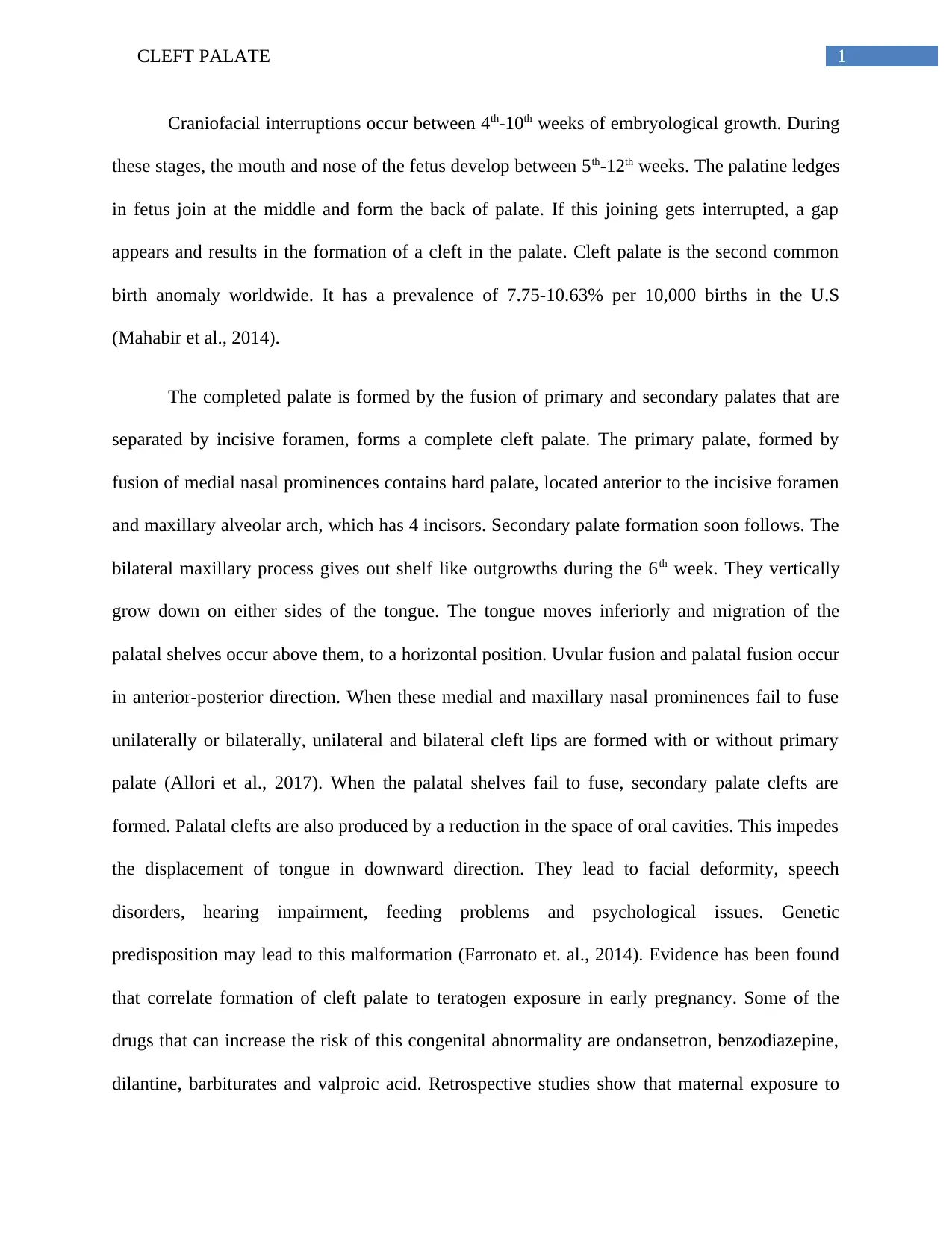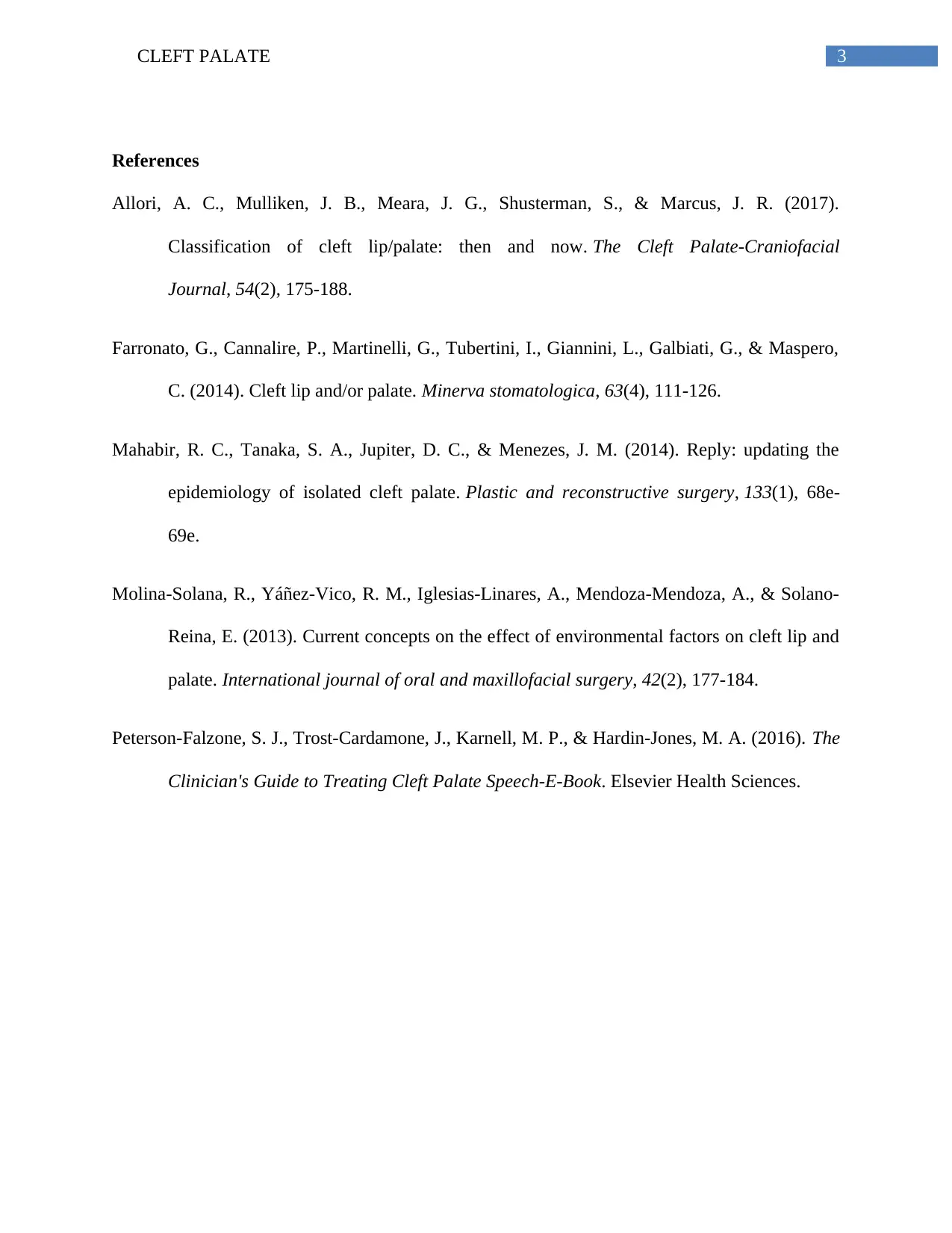Cleft Palate: Etiology, Treatment, and Implications Report
VerifiedAdded on 2019/11/08
|4
|852
|381
Report
AI Summary
This report provides a comprehensive overview of cleft palate, a tooth developmental disorder. It begins by detailing the embryological development of the mouth and nose, emphasizing the critical period between the 4th and 10th weeks of gestation. The report explains the process of palatal fusion a...

Running head: CLEFT PALATE
Tooth developmental disorder- Cleft Palate
Name of the Student
Name of the University
Author Note
Tooth developmental disorder- Cleft Palate
Name of the Student
Name of the University
Author Note
Paraphrase This Document
Need a fresh take? Get an instant paraphrase of this document with our AI Paraphraser

1CLEFT PALATE
Craniofacial interruptions occur between 4th-10th weeks of embryological growth. During
these stages, the mouth and nose of the fetus develop between 5th-12th weeks. The palatine ledges
in fetus join at the middle and form the back of palate. If this joining gets interrupted, a gap
appears and results in the formation of a cleft in the palate. Cleft palate is the second common
birth anomaly worldwide. It has a prevalence of 7.75-10.63% per 10,000 births in the U.S
(Mahabir et al., 2014).
The completed palate is formed by the fusion of primary and secondary palates that are
separated by incisive foramen, forms a complete cleft palate. The primary palate, formed by
fusion of medial nasal prominences contains hard palate, located anterior to the incisive foramen
and maxillary alveolar arch, which has 4 incisors. Secondary palate formation soon follows. The
bilateral maxillary process gives out shelf like outgrowths during the 6th week. They vertically
grow down on either sides of the tongue. The tongue moves inferiorly and migration of the
palatal shelves occur above them, to a horizontal position. Uvular fusion and palatal fusion occur
in anterior-posterior direction. When these medial and maxillary nasal prominences fail to fuse
unilaterally or bilaterally, unilateral and bilateral cleft lips are formed with or without primary
palate (Allori et al., 2017). When the palatal shelves fail to fuse, secondary palate clefts are
formed. Palatal clefts are also produced by a reduction in the space of oral cavities. This impedes
the displacement of tongue in downward direction. They lead to facial deformity, speech
disorders, hearing impairment, feeding problems and psychological issues. Genetic
predisposition may lead to this malformation (Farronato et. al., 2014). Evidence has been found
that correlate formation of cleft palate to teratogen exposure in early pregnancy. Some of the
drugs that can increase the risk of this congenital abnormality are ondansetron, benzodiazepine,
dilantine, barbiturates and valproic acid. Retrospective studies show that maternal exposure to
Craniofacial interruptions occur between 4th-10th weeks of embryological growth. During
these stages, the mouth and nose of the fetus develop between 5th-12th weeks. The palatine ledges
in fetus join at the middle and form the back of palate. If this joining gets interrupted, a gap
appears and results in the formation of a cleft in the palate. Cleft palate is the second common
birth anomaly worldwide. It has a prevalence of 7.75-10.63% per 10,000 births in the U.S
(Mahabir et al., 2014).
The completed palate is formed by the fusion of primary and secondary palates that are
separated by incisive foramen, forms a complete cleft palate. The primary palate, formed by
fusion of medial nasal prominences contains hard palate, located anterior to the incisive foramen
and maxillary alveolar arch, which has 4 incisors. Secondary palate formation soon follows. The
bilateral maxillary process gives out shelf like outgrowths during the 6th week. They vertically
grow down on either sides of the tongue. The tongue moves inferiorly and migration of the
palatal shelves occur above them, to a horizontal position. Uvular fusion and palatal fusion occur
in anterior-posterior direction. When these medial and maxillary nasal prominences fail to fuse
unilaterally or bilaterally, unilateral and bilateral cleft lips are formed with or without primary
palate (Allori et al., 2017). When the palatal shelves fail to fuse, secondary palate clefts are
formed. Palatal clefts are also produced by a reduction in the space of oral cavities. This impedes
the displacement of tongue in downward direction. They lead to facial deformity, speech
disorders, hearing impairment, feeding problems and psychological issues. Genetic
predisposition may lead to this malformation (Farronato et. al., 2014). Evidence has been found
that correlate formation of cleft palate to teratogen exposure in early pregnancy. Some of the
drugs that can increase the risk of this congenital abnormality are ondansetron, benzodiazepine,
dilantine, barbiturates and valproic acid. Retrospective studies show that maternal exposure to

2CLEFT PALATE
smoking, retinoic acid and alcohol during the first trimester of pregnancy increases the likelihood
of the fetus to have oral clefts (Molina-Solana et al., 2013). These teratogens delay the closure
time during palate formation and lead to this malformation.
Treatment procedures are generally done within 12 months. Wider clefts are operated
after the palatal shelves grow inwards and come closer. Surgeons close the cleft in the nasal
lining, oral lining and the muscles. Palate repair is performed to improve speech, restore function
of Eustachian tube, close oronasal fistula and minimize maxillary growth alterations. Incisions
are made on either sides of the cleft and tissues are moved towards the midline or centre of the
roof of the mouth. The palate gets rebuilt and the muscles are joined together. This leads to an
increase in the length of the palate (Peterson-Falzone et al., 2016). This restores the feeding
pattern and speech skills in the child. Speech therapies are also practiced in some children.
Pharyngoplasty is carried out in those who report persistent speech problems. Fine refinements in
the palate are often done by a maxillofacial surgeon in teenagers. Thus, cleft palate treatment
involves plastic surgeons, speech therapisits, ENT surgeons and orthodontists.
smoking, retinoic acid and alcohol during the first trimester of pregnancy increases the likelihood
of the fetus to have oral clefts (Molina-Solana et al., 2013). These teratogens delay the closure
time during palate formation and lead to this malformation.
Treatment procedures are generally done within 12 months. Wider clefts are operated
after the palatal shelves grow inwards and come closer. Surgeons close the cleft in the nasal
lining, oral lining and the muscles. Palate repair is performed to improve speech, restore function
of Eustachian tube, close oronasal fistula and minimize maxillary growth alterations. Incisions
are made on either sides of the cleft and tissues are moved towards the midline or centre of the
roof of the mouth. The palate gets rebuilt and the muscles are joined together. This leads to an
increase in the length of the palate (Peterson-Falzone et al., 2016). This restores the feeding
pattern and speech skills in the child. Speech therapies are also practiced in some children.
Pharyngoplasty is carried out in those who report persistent speech problems. Fine refinements in
the palate are often done by a maxillofacial surgeon in teenagers. Thus, cleft palate treatment
involves plastic surgeons, speech therapisits, ENT surgeons and orthodontists.
⊘ This is a preview!⊘
Do you want full access?
Subscribe today to unlock all pages.

Trusted by 1+ million students worldwide

3CLEFT PALATE
References
Allori, A. C., Mulliken, J. B., Meara, J. G., Shusterman, S., & Marcus, J. R. (2017).
Classification of cleft lip/palate: then and now. The Cleft Palate-Craniofacial
Journal, 54(2), 175-188.
Farronato, G., Cannalire, P., Martinelli, G., Tubertini, I., Giannini, L., Galbiati, G., & Maspero,
C. (2014). Cleft lip and/or palate. Minerva stomatologica, 63(4), 111-126.
Mahabir, R. C., Tanaka, S. A., Jupiter, D. C., & Menezes, J. M. (2014). Reply: updating the
epidemiology of isolated cleft palate. Plastic and reconstructive surgery, 133(1), 68e-
69e.
Molina-Solana, R., Yáñez-Vico, R. M., Iglesias-Linares, A., Mendoza-Mendoza, A., & Solano-
Reina, E. (2013). Current concepts on the effect of environmental factors on cleft lip and
palate. International journal of oral and maxillofacial surgery, 42(2), 177-184.
Peterson-Falzone, S. J., Trost-Cardamone, J., Karnell, M. P., & Hardin-Jones, M. A. (2016). The
Clinician's Guide to Treating Cleft Palate Speech-E-Book. Elsevier Health Sciences.
References
Allori, A. C., Mulliken, J. B., Meara, J. G., Shusterman, S., & Marcus, J. R. (2017).
Classification of cleft lip/palate: then and now. The Cleft Palate-Craniofacial
Journal, 54(2), 175-188.
Farronato, G., Cannalire, P., Martinelli, G., Tubertini, I., Giannini, L., Galbiati, G., & Maspero,
C. (2014). Cleft lip and/or palate. Minerva stomatologica, 63(4), 111-126.
Mahabir, R. C., Tanaka, S. A., Jupiter, D. C., & Menezes, J. M. (2014). Reply: updating the
epidemiology of isolated cleft palate. Plastic and reconstructive surgery, 133(1), 68e-
69e.
Molina-Solana, R., Yáñez-Vico, R. M., Iglesias-Linares, A., Mendoza-Mendoza, A., & Solano-
Reina, E. (2013). Current concepts on the effect of environmental factors on cleft lip and
palate. International journal of oral and maxillofacial surgery, 42(2), 177-184.
Peterson-Falzone, S. J., Trost-Cardamone, J., Karnell, M. P., & Hardin-Jones, M. A. (2016). The
Clinician's Guide to Treating Cleft Palate Speech-E-Book. Elsevier Health Sciences.
1 out of 4
Your All-in-One AI-Powered Toolkit for Academic Success.
+13062052269
info@desklib.com
Available 24*7 on WhatsApp / Email
![[object Object]](/_next/static/media/star-bottom.7253800d.svg)
Unlock your academic potential
© 2024 | Zucol Services PVT LTD | All rights reserved.